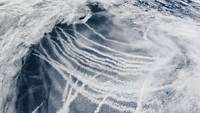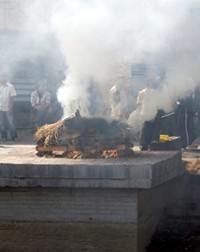Advertisement
Grab your lab coat. Let's get started
Welcome!
Welcome!
Create an account below to get 6 C&EN articles per month, receive newsletters and more - all free.
It seems this is your first time logging in online. Please enter the following information to continue.
As an ACS member you automatically get access to this site. All we need is few more details to create your reading experience.
Not you? Sign in with a different account.
Not you? Sign in with a different account.
ERROR 1
ERROR 1
ERROR 2
ERROR 2
ERROR 2
ERROR 2
ERROR 2
Password and Confirm password must match.
If you have an ACS member number, please enter it here so we can link this account to your membership. (optional)
ERROR 2
ACS values your privacy. By submitting your information, you are gaining access to C&EN and subscribing to our weekly newsletter. We use the information you provide to make your reading experience better, and we will never sell your data to third party members.
Environment
Reining In Brown Clouds
Cuts in regional, black-carbon-laden air pollution could quickly help curb global warming
by Cheryl Hogue
August 24, 2009
| A version of this story appeared in
Volume 87, Issue 34

Across parts of Earth are massive swaths of brownish air covering thousands of square miles. Thick with lung-choking pollutants, these so-called brown clouds dim the surface below them and contain particles that are potent agents of global warming. In addition, some scientists say brown clouds are altering regional precipitation patterns in Asia.
Calls are growing to clean up emissions that form brown clouds. This, proponents says, will help curb global warming in the short term, significantly improve people’s health, and help protect the flow of major rivers that millions of people depend on for water.
A brown cloud is a soup of pollutants. It contains nanometer- to micrometer-sized soot particles, sulfates, nitrogen oxides, ground-level ozone, and fly ash, which is a residue from coal burning. Imparting the clouds’ brownish color are nitrogen dioxide gas and aerosols including fly ash, soil particles that are suspended in air, and black carbon, a product of incomplete combustion. These particulates are linked to respiratory problems. And black carbon, which absorbs sunlight, is a major contributor to human-induced climate change, ranked as second after carbon dioxide (Nat. Geosci. 2008, 1, 221).
The first brown cloud was identified about a decade ago over Southern Asia. But such clouds are not limited to Asia. Brown clouds are all over the world, a recent report by the United Nations Environment Program (UNEP) points out.
Five areas are so heavily affected by brown clouds that at least 10% of incoming sunlight is blocked from reaching them, UNEP says. One is East Asia, covering eastern China. Another extends from eastern Pakistan across India into Bangladesh and Myanmar (formerly Burma). A third is in Southeast Asia—in Cambodia, Indonesia, Thailand, and Vietnam. The two other major brown clouds are on southern continents. One covers the Amazon basin, and the other is south of the Sahara Desert over Angola, Zambia, and Zimbabwe.
Brown clouds also persist over the eastern U.S. and Europe. In these temperate areas, the brown hazes build up mainly in summer, according to the UNEP report. In contrast, brown clouds in the tropics grow and wane with the seasons, with pollutants accumulating during the dry season.
Much of the research on brown clouds has focused on the effects of the black carbon and sulfates they contain.
Black carbon is composed of elemental carbon with some organic compounds mixed in. It has less elemental carbon than the commercial product carbon black, which is used as a pigment and as the raw material for nanomaterials. Forest fires produce black carbon, and so does the burning of coal, diesel fuel, and crop residues, as well as of wood or dung for domestic heating and cooking. During the days to weeks that black-carbon particles are aloft in the atmosphere, they contribute to global warming by absorbing sunlight and heating the surrounding air.
Black carbon’s warming effect doesn’t necessarily cease when the particles fall out of the sky with rain or snow. If they land on ice or snow, the particles hasten melting because they’re still absorbing sunlight. Plus, they reduce the ability of ice or snow to reflect sunlight into space, which helps cool the planet.
“The evidence is getting very, very strong” about black carbon’s ability to increase atmospheric heating, says Veerabhadran Ramanathan, head of a UNEP scientific panel that is carrying out research on brown clouds. He is a professor of climate and atmospheric sciences and of applied ocean sciences at Scripps Institution of Oceanography, part of the University of California, San Diego.
Counteracting some of brown clouds’ warming because of black carbon are the sulfates they contain, the UNEP report explains. Sulfate aerosols form in the atmosphere from sulfur dioxide released by the burning of diesel and coal. Sulfates exert a cooling influence because these particles reflect sunlight into space.

Both black carbon and sulfates, however, diminish the amount of light that penetrates the atmosphere and thus dim Earth’s surface. Land surfaces of China and India get at least 6% less sunlight than they did before these countries industrialized, according to the UNEP report, which took a close look at brown clouds over Asia. And this dimming, the report says, is considered a major cause for precipitation shifts in Asia over recent decades.
The argument is that dimming leads to cooling of land and ocean surfaces, which means less evaporation and thus less rainfall. Meanwhile, the atmosphere gets warmer and is less prone to thunderstorms, further reducing rainfall. Less precipitation means sulfates and black carbon stay in the atmosphere longer. And the longer these pollutants remain airborne, the longer they exert their dimming effect on Earth.
Some in the scientific community are skeptical that brown clouds influence precipitation patterns. The skepticism is not surprising, Ramanathan says, because “our whole understanding of regional climate change is in its infancy.” But published findings that brown clouds are reducing the amount of sunlight reaching the surface are undisputed, he says.
In addition, large brown clouds in Asia threaten water supplies for billions of people, Ramanathan and the UNEP report contend. Through warming the atmosphere and by changing patterns of precipitation, brown clouds are causing the retreat of glaciers and snow packs that feed several major rivers—the Brahmaputra, Ganges, Indus, Mekong, and Yangtze. Although this waning may increase water supplies temporarily, glaciers will provide less flow to rivers over the longer term. At the current rate of retreat, glaciers will shrink by 75% by 2050, according to the UNEP report. Shrinking glaciers in the Himalayas, in the Hindu Kush mountain range of Afghanistan and Pakisan, and in the Tibetan plateau have serious implications for water and food security in Asia, Ramanathan emphasizes.
Concerns about the effects of brown clouds on Asian water supplies, on human health, and on human-induced climate change across the globe provide a strong motivation for cleaning up brown clouds internationally. A few policy groups and environmental activists are calling for global cutbacks in black-carbon emissions. Reducing amounts of this particulate in the air would begin to lower human-induced global warming almost at once, many scientists agree. In contrast, reducing emissions of carbon dioxide and other greenhouse gases will not lead to significant cooling for decades because these gases stay in the atmosphere for many years.
Policy analysts warn, however, that the politics of international environmental cooperation on black carbon have to be approached carefully, especially in light of the standoff in the negotiations on the climate-change treaty that is expected to be completed in December in Copenhagen.
Climate negotiators are learning about and discussing black carbon, says Erika Rosenthal, an attorney with the environmental group Earthjustice who is attending this year’s climate talks. However, the negotiators want to finish their work on the new treaty first before turning to possible global controls on black-carbon emissions, she says.
There could be other avenues for international cooperation to address black carbon. For example, Ramanathan and Jessica S. Wallack, of the Institute for Financial & Management Research, in Chennai, India, are suggesting that countries hammer out bilateral or regional deals to address black-carbon emissions. In the upcoming September issue of Foreign Affairs, they argue that such agreements would be faster and simpler to create and update than would be adding pollutants to the global-climate-change discussions.
Controlling the short-lived contaminants that characterize brown clouds would give fast, visible results—namely, less visible pollution—with immediate benefits for people’s health and Earth’s climate, Ramanathan tells C&EN. Politicians and the public would see the effect of control policies within a few weeks, he adds.





Join the conversation
Contact the reporter
Submit a Letter to the Editor for publication
Engage with us on Twitter